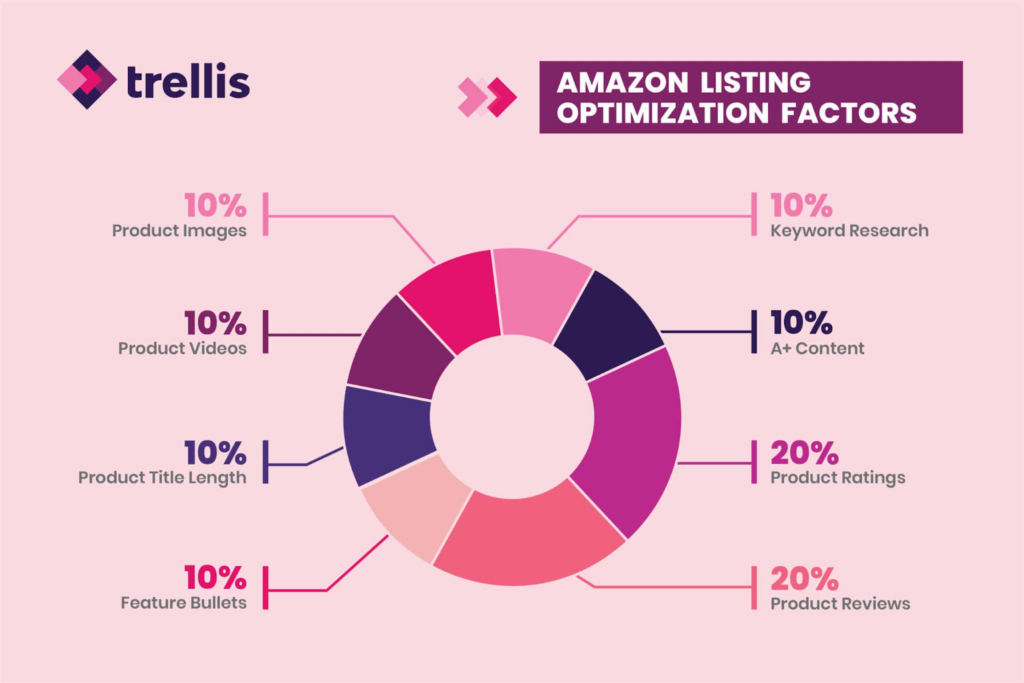Table of Contents
ToggleIn 2023, global retail e-commerce sales reached an estimated 5.8 trillion U.S. dollars. Projections dictate a 39 per cent growth expected to surpass eight trillion dollars by 2027. That’s how important an ecommerce strategy can be in today’s competitive marketplace.
While a holistic ecommerce strategy encompasses many vital components – streamlined checkout, personalized marketing, user-friendly design, efficient inventory management, and exceptional customer service – optimized product listings are unequivocally the bedrock upon which all else is built. They are the digital equivalent of your salesperson on the shop floor, your product packaging on the shelf, and your most persuasive advertisement, all rolled into one. Neglecting this critical element is akin to opening a physical store with blank boxes on the shelves.
This section expands significantly on the crucial elements of product listing optimization, transforming it from a brief mention into the comprehensive foundation it deserves.
There are 6 essential elements to crafting a knockout ecommerce strategy that this article will address. Let’s look at it –
Why Optimization is Non-Negotiable: Beyond Mere Visibility
Optimization isn’t just about getting found; it’s about converting browsers into buyers once they land on your page. It directly impacts:
- Search Visibility (SEO): How easily customers find your products via search engines (Google, Bing) and marketplace/internal search (Amazon, eBay, Shopify search). Relevant keywords are the map.
- Click-Through Rate (CTR): How compelling your listing appears in search results or category pages to entice a click. Titles and images are the hook.
- Conversion Rate (CRO): How effectively your listing convinces a visitor viewing the product page to add to cart and purchase. Descriptions, images, details, and trust signals are the closest.
- Customer Trust & Reduced Returns: Clear, accurate, and detailed listings manage expectations, build trust, and minimize costly returns due to product mismatch or misinformation.
- Competitive Advantage: In saturated markets, a superior listing can be the decisive factor that wins the sale over a competitor with a similar product but a poorly presented page.
Optimized Product Listings
Product Titles in Ecommerce Strategy: The Critical First Impression & SEO Anchor Point
Uniqueness: Avoid duplicate titles across similar products. Each SKU needs a distinct, descriptive title.
Purpose: Capture attention in search results, clearly identify the product, incorporate primary keywords, and differentiate from competitors.
Optimal Structure:Primary Keyword + Key Brand/Model + Key Feature/Benefit + Key Attribute (Size, Color, Quantity). Avoid keyword stuffing.
Example (Bad): “Great Shoes for Running”
Example (Good): “Nike Air Zoom Pegasus 39 Men’s Road Running Shoes – Size 10, Black/Volt – Lightweight Cushioning”
Key Considerations:
Keyword Research is Paramount: Use tools like Google Keyword Planner, SEMrush, Ahrefs, Helium 10 (for marketplaces), MerchantWords, or even analyze competitor listings and Amazon/Google autocomplete suggestions. Identify high-intent, commercially relevant keywords customers actually use.
Front-Load Keywords: Place the most crucial keywords (brand, product type, core feature) near the beginning. Search algorithms and skimming customers prioritize the start.
Be Specific & Accurate: Include essential details like size, color, quantity, material, or model number if applicable. Avoid vague terms like “amazing” or “best.”
Character Limits: Adhere to platform limits (e.g., Amazon typically allows 200 characters, Google Shopping has specific guidelines). Prioritize clarity and essential keywords within the limit.
Mobile Optimization: Ensure titles are readable and impactful on smaller screens. Avoid excessive length that truncates poorly.

Image Source: Trellis
Additionally, it’s important to provide detailed information about each product, such as materials, dimensions, and weight, to help customers make informed purchasing decisions.
Product Descriptions: Persuasion, Information & Keyword Context
- Purpose: Sell the benefits, explain features in context, answer unspoken questions, overcome objections, incorporate secondary keywords naturally, and build desire.
- Structure & Best Practices:
- Hook: Start with a compelling sentence addressing the core problem the product solves or the primary desire it fulfills.
- Benefit-Driven Features: Don’t just list features (“Stainless steel blade”). Explain the benefit (“Stainless steel blade ensures razor-sharp precision for effortless cutting and exceptional longevity, resisting rust and corrosion”).
- Scannability: Use bullet points for key features and specifications. Break text into short paragraphs. Utilize subheadings (H2, H3 tags, where possible for SEO).
- Storytelling & Emotion: Connect with the customer. How does this product improve their life? What experience does it enable? Paint a picture.
- Keyword Integration: Weaving relevant keywords is a part of any good ecommerce strategy (including long-tail variations and synonyms) naturally throughout the descriptive text. Avoid awkward stuffing.
- Target Audience Voice: Write in the language your customer uses. Is it technical? Playful? Luxurious? Match their tone.
- Address Objections: Proactively counter common reasons not to buy (e.g., “Worried about assembly? Our tool-free design takes just 5 minutes!”).
- Clear Calls to Action (Subtle): While the main CTA is the “Add to Cart” button, the description should build towards that action (“Experience the difference today,” “Upgrade your routine,” “Get yours now”).
- Completeness: Cover materials, key dimensions, intended use, care instructions, and what’s included in the box.
High-Quality Visuals: The Power of Seeing is Believing in ECommerce Strategy
- Purpose: Showcase the product accurately, demonstrate scale and detail, build desire, show usage context, and build trust. Visuals are processed 60,000x faster than text by the human brain.
- Image Requirements & Best Practices:
- Resolution & Clarity: High-resolution, professional, crisp, well-lit photos (minimum 1000px width, often 2000px+ preferred). No blurriness or pixelation. White backgrounds are standard for primary images on many platforms (check requirements).
- Multiple Angles: Front, back, sides, top, bottom. Show the product in its entirety.
- Close-Ups: Highlight key features, textures, materials, craftsmanship, labels, or intricate details.
- Scale/Context Shots: Show the product in use or alongside common objects (e.g., a coffee mug next to a blender, a person wearing clothing). Lifestyle shots are incredibly powerful.
- Consistency: Maintain a consistent style, lighting, and background (where appropriate) across all product images for a professional brand feel is another critical element of any ecommerce strategy.
- Alt Text (Alternative Text): Crucial for SEO and accessibility. Describe the image accurately and concisely, incorporating relevant keywords (e.g., “Woman hiking in blue Columbia waterproof jacket on mountain trail”).
- Video Content: Product videos significantly boost conversion. Show the product in action, demonstrate features, and showcase different angles fluidly. Even short (15-30 second) videos are highly effective.
- 360-Degree Views: Allow users to interactively spin the product for a comprehensive view, especially valuable for complex items or apparel.
- User-Generated Content (UGC): Integrate customer photos/videos (with permission). This builds immense social proof and shows real-world usage.
Detailed Product Information & Specifications: Building Trust & Reducing Uncertainty with ECommerce Strategy
- Purpose: Provide the factual details customers need to make an informed decision, reduce pre-purchase anxiety, minimize returns, and answer technical questions before they arise. This is where you build trust through transparency.
- Essential Elements (Structured Data is Key):
- SKU/UPC/ISBN: Unique product identifiers.
- Brand: Clearly stated.
- Key Specifications: Dimensions (LxWxH), weight, material composition, color(s), size/quantity options, capacity, power requirements, model number.
- Features: Bulleted list of key technical or functional attributes.
- Compatibility/Requirements: What does it work with? (e.g., “Requires iOS 16+,” “Compatible with Samsung Galaxy S20-S23”). What’s needed to use it? (e.g., “Batteries not included”).
- Included Accessories: Clearly state what comes in the box.
- Care/Maintenance Instructions: Essential for apparel, appliances, furniture.
- Warranty Information: Duration and coverage details.
- Safety Certifications: (e.g., UL, CE, FCC) – crucial for electronics, children’s products, etc.
- Implementation: Use clear, standardized labels and values. Utilize structured data markup (Schema.org –
Product,Offer,AggregateRating) to help search engines understand and display your product information more effectively in rich results.
Leveraging Social Proof: Harnessing the Voice of the Customer
- Purpose: Build trust, reduce perceived risk, provide authentic validation, and answer specific user questions. Social proof is one of the most powerful conversion drivers.
- Key Tactics:
- Customer Reviews & Ratings: Actively solicit reviews post-purchase (via email/SMS sequences). Display them prominently, including both star ratings and written reviews. Respond professionally to all reviews, especially negative ones, showing you care and resolve issues. Implement verified purchase badges.
- Q&A Sections: Allow potential customers to ask questions and get answers from past buyers or your team. This proactively addresses concerns that might otherwise block a sale. Monitor and respond promptly.
- Testimonials & Case Studies: For higher-value or complex products, showcase detailed customer success stories.
- Badges & Trust Seals: Display security badges (SSL, McAfee Secure), payment method icons, return policy badges, and awards to reinforce trust.
Mobile Optimization: The Non-Negotiable Reality in ECommerce Strategies
- Purpose: Ensure an exceptional user experience for the majority of shoppers who browse and buy on smartphones.
- Critical Actions:
- Responsive Design: Listings must render perfectly on all screen sizes. Test rigorously.
- Image & Video Optimization: Ensure visuals load quickly on mobile networks. Use appropriate formats and compression.
- Scannable Text: Short paragraphs, ample white space, clear bullet points. Font size must be easily readable.
- Touch-Friendly Elements: Buttons (Add to Cart, size/color selectors) must be large enough and well-spaced to avoid mis-taps.
- Fast Loading Speed: Mobile users abandon slow pages instantly. Optimize images, minimize code, leverage caching.
Streamlined Checkout Process

Image Source: Nimbbl
A streamlined checkout process is critical for reducing cart abandonment rates and increasing conversions. To optimize your checkout process, consider offering features like one-click ordering, guest checkouts, and mobile optimization. Additionally, ensure that your payment gateway is secure and reliable and offers various payment options to cater to different customer preferences.
Personalized Marketing Campaigns in Your Ecommerce Strategy

Image Source: WebFX
Personalization is key to creating engaging marketing campaigns that resonate with your target audience. Use data and analytics to segment your customer base and tailor your messaging accordingly. For example, send targeted email campaigns based on purchase history or browsing behavior, and use social media advertising to reach specific demographics. Personalization helps build trust and increases the likelihood of repeat business.
User-Friendly Website Design
Your website is often the first point of contact between your brand and potential customers. A user-friendly design can significantly impact their shopping experience and influence their decision to buy from you. Ensure that your site is easy to navigate, has clear calls to action, and loads quickly across all devices. Consider investing in UX testing to identify areas of improvement and optimize the overall user experience.
Effective Inventory Management

Image Source: NetSuite
Effective inventory management is vital for maintaining customer satisfaction and avoiding lost sales due to stockouts or overstocking. Implement a robust inventory management system that provides real-time updates on stock levels, tracks orders, and automates restocking processes. This will help prevent overselling, reduce waste, and improve supply chain efficiency.
Exceptional Customer Service
Lastly, customer service is crucial for building brand loyalty and encouraging positive word-of-mouth marketing. Provide multiple channels for customers to interact with your support team, such as phone, email, and live chat. Respond promptly to inquiries, address concerns courteously, and resolve issues efficiently. Consider implementing a rewards program or loyalty scheme to incentivize repeat business further.
The above elements craft a compelling ecommerce strategy that can boost sales and grow the customer base.
Ecommerce insights help businesses stay current and updated on different metrics that can boost business performance. That, equipped with the relevant ecommerce market intelligence tools to understand digital shelf analytics and voice of customer analytics, is enough data for companies to see growth.
If you are interested in knowing more about ecommerce analytics and how it can help your business, sign up for a free trial today.
Frequently Asked Questions
What are the 4 C’s of e-commerce?
Content: The information and media that is presented on an e-commerce website, including product descriptions, images, videos, and other types of content that help customers learn about and engage with products.
Commerce: The transactional aspect of e-commerce, including the ability for customers to purchase products online, payment processing, order management, and fulfilment.
Community: The social aspects of e-commerce, including user-generated content, customer reviews, ratings, and discussions facilitate interaction between customers and foster a sense of community around a brand or product.
Convenience: The ease and speed with which customers can find, purchase, and receive their desired products, including features like easy navigation, search functionality, mobile optimization, and fast shipping options.
What are the three pillars of ecommerce strategy?
The three pillars of e-commerce strategy are:
Customer experience: Creating a seamless, intuitive, and personalized shopping experience that meets the needs and exceeds the expectations of customers. This includes offering a wide range of products, providing accurate and detailed product information, and ensuring that the checkout process is simple and efficient.
Operational efficiency: Streamlining business processes and leveraging technology to minimize costs, improve productivity, and maximize profitability. This includes optimizing supply chain management, inventory control, and logistics, as well as implementing effective marketing strategies.
Innovation: Staying ahead of the curve by embracing new technologies, experimenting with new business models, and continuously improving the customer experience. This includes investing in research and development, testing new products and services, and iterating based on customer feedback.







